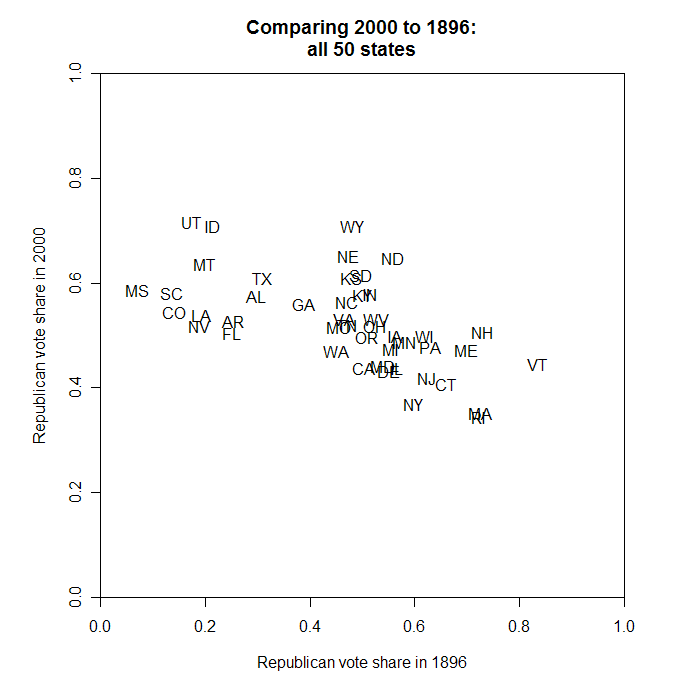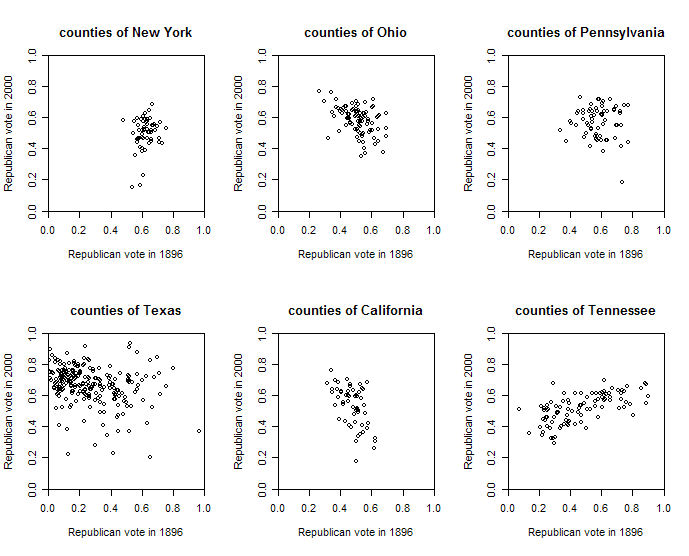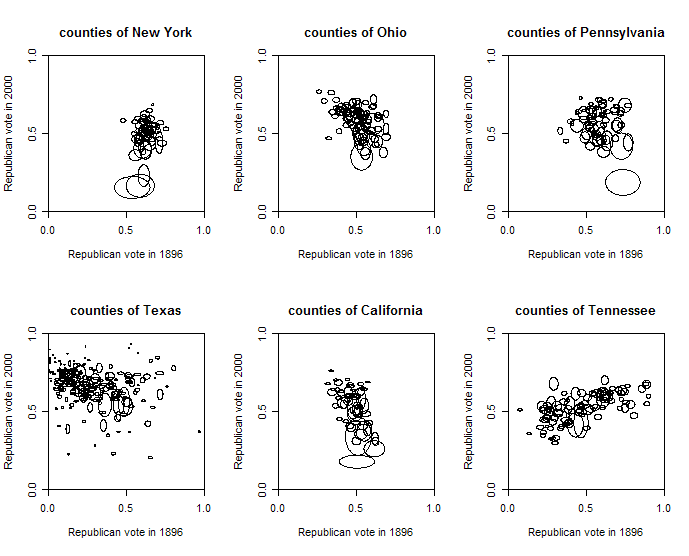In the article, “Activists and partisan realignment in the United States,” published in 2003 in the American Political Science Review, Gary Miller and Norman Schofield point out that the states won by the Democrats and Republicans in recent elections are almost the opposite of the result of the election of 1896:

Miller and Schofield describe this as a complete reversal of the parties’ positions. In their story, in 1896 the parties competed on social (racial) issues, with the Republicans on the left and the Democrats on the right. Then the parties gradually moved around in the two dimensional social/economic issue space, until from the 1930s through the 1960s, the parties primarily competed on economic issues. Since then, in the Miller/Schofield story, the parties continued to move until now they compete primarily on social issues, but now with the Democrats on the left and the Republicans on the right.
It’s an interesting argument but I have some problems with it. First off, it was my impression that the 1896 election was all about economic issues, with the Democrats supporting cheap money and easy credit (W. J. Bryan’s “cross of gold” speech) and the Republicans representing big business. At least in that election, it was the Democrats on the left on economic issues and the Republicans on the right.
Getting to recent elections, the evidence from surveys and from roll call votes is that the Democrats and Republicans are pretty far apart on economic issues, again with the D’s on the left and the R’s on the right. So, from that perspective, it’s not the parties that have changed positions, it’s the states that have moved. The industrial northeastern and midwestern states have moved from supporting conservative economic policies to a more redistributionist stance. Which indeed is something of a mystery, and it’s related to attitudes on social issues, but I certainly wouldn’t say that economic issues don’t matter anymore. According to Ansolabehere, Rodden, and Snyder, social issues are more important now in voting than they were 20 years ago, but economic issues are still voters’ dominant concern.
1896 vs. 2000 by counties within each state
Here are some more pretty pictures. First, within 6 selected states, a scatterplot of Bush vote share in 2000 vs. McKinley vote share in 1896. There are completely different patterns in different states! Nothing like as clean a pattern as the statewide plot above.

And here’s another plot, this time showing each county as an ellipse, with the size of the ellipse proportional to the population of the county (more precisely, the voter turnout) in the two elections.

Nowadays the Democrats clearly do better in the big cities (in these graphs, the large-population counties). In 1896 the pattern wasn’t so clear. I’d be interested to know what Jonathan Rodden thinks of all this. . .
I think this is less a racial or even economic issue, and more of a urban vs. rural issue.
Urbanites used to be Republicans and now they're Democrats. Modern urbanism tends toward collectivism due to the expensive externalities of dense population.
I think it's also revealing that the most extreme states are 60/40. There are plenty of conservatives in Vermont and plenty of collectivists/socialists in Alabama.
Your post happens to intersect with something I've just been working on, which is a graphical representation of the Poole-Rosenthal NOMINATE data. It deals with a similar question, that is: How have the parties changed over the last 150-or-so years? I can't claim that the ideas are original, but I think the presentation tells a fairly good story. Check it out at http://www.duke.edu/~dbs9/senatehistory.html .
Isn't the conventional explanation that Southern states wouldn't vote for the Republicans — the anti-slavery Party of Lincoln, and all that — for several generations after the Civil War? I thought the more or less standard story was that white Southerners voted strongly Democratic for reasons that had little to do with actual policies, until the big cultural break of 1980. I'm not saying this is true, just that this is what I've heard as conventional wisdom for about the last 20 years. And admittedly this doesn't explain "what's the matter with" Montana, Massachusetts, etc.!
Brian,
But in 1896 the Democrats actually won the big cities which tended to have Democratic "machines" (except in Pennsylvania, which had a Republican "machine").
From what I've read, the original republican party was mainline protestant and the democrats were episcopal, jewish, and catholic,. Evangelicals drifted between the two parties. They were mainly dems during William Jennings Bryan but they have been repubs since Reagan. Carter got a little over half the evangelical vote. A lot of the "Rockefeller" republicans in the northeast have voted democrat in national elections throughout the Bush years but there has been a lingering sentiment for fiscal management conservatives (i.e Jody Rell, Romney, Shays, Snowe, Pataki, Giuliani, Bloomberg) at the local level.
I do not have county-level data at my fingertips, but I'm looking at the relationship between population density and Democrat voting in presidential elections at the level of congressional districts. My data only go back to the 1950s. A significant positive relationship has been discernable since 1952, but it seems to have grown stronger since 1980. If I can figure out how to post the graphs, I will do so. Andrew, do you have relevant county-level data since the 1800s? I would like to see when this relationship developed, in which states, etc. My hunch is that suburbanization, especially after the race riots, significantly reduced the heterogeneity of cities. The era of Democrats winning 80 percent of the presidential vote in big cities seems fairly recent.